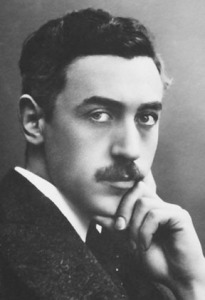 Hämnaren (The Avenger)
Hämnaren (The Avenger)
R: Mauritz Stiller. B: Martin Jørgensen, Louis Levy. K: Hugo Edlund. D: Wilhelm Hansson, Edith Erastoff, Edmond Hansen, Richard Lund, Gustaf Callmén, Tyra Dörum, John Ekman. P: Svenska Biografteatern. Sw 1915
Print: Filmarkivet Svenska Filminstitutet
Span. subtitles
Print temporarily not available. Here is a fragment:
“Swedish filmmaker Mauritz Stiller (1883-1928) was, next to Victor Sjöström, the greatest director of Swedish cinema’s golden age. Stiller, the Helsinki-born son of Russian-Polish Jewish parents, was orphaned at four and then adopted by the Katzmans, a family of haberdashers. As a youth he attended Hebrew school, took violin lessons and apprenticed at their business until he was conscripted into the Czar’s army. Rather than serve he escaped to Sweden. He got involved in the Swedish film industry in 1912. Like his colleague Sjöström, Stiller was able to create sophisticated, lyrical films that earned Swedish cinema great international respect. His early films were usually elegant social satires, but after World War I, he began making epic adaptations of popular novels, those of Selma Lagerlöf in particular. On of those adaptations The Atonement of Gosta Berling (1924) introduced Greta Garbo, his protogée. At the invitation of mogul Louis B. Mayer, Stiller and Garbo went to Hollywood where her career exploded while his lagged behind as he found himself constantly battling the confines of the Hollywood studio system. His first American Garbo film, The Temptress (1926), was taken away from him. He found success with his next two films, but in all, he was not impressed with Hollywood and returned to Sweden in the late twenties. There he died of acute rheumatism at age 45.”
Sandra Brennan, Rovi
Fandango
“Mauritz Stiller and Victor Sjöström emerged as two of Sweden’s greatest pioneer directors, and Stiller’s The Avenger (1915) and Sjöström’s Kiss of Death (1916) offer glimpses of what was soon to come — although Sjöström had already directed Ingeborg Holm (1913), which film critic Andrew Sarris suspects may be the movies’ first masterpiece.
The Avenger, about a pregnant Jewish woman’s rejection by her Gentile lover and its consequences to the next generation, is strongly steeped in the coincidental and the didactic. It is far removed from the sophisticated fare that would make Stiller a rival to Lubitsch — yet the story must have been exceptionally close to his heart.”
Kevin Thomas
Leaders in the silent era of film
Madame de Thèbes
R: Mauritz Stiller. B: Martin Jørgensen, Louis Levy. K: Julius Jaenzon. D: John Ekman, Märta Halldén, Nicolai Johannsen, William Larsson, Albin Lavén, Karin Molander. P: Svenska Biografteatern. Sw 1915
Print: Stiftung Deutsche Kinemathek / Svenska Filminstitutet
“Madame de Thèbes (1845–1916), pseudonym of Anne Victorine Savigny, was a French clairvoyant and palm reader. She plied her trade from her living room at No. 29 Avenue de Wagram in Paris. Every Christmas, she published her prophecies in an Almanac, which enjoyed wide circulation. She was said to have predicted: The Boer War, the Russo-Japanese War, Triggers of World War I (and more). She published the book ‘The Enigma of the Dream: Explanation of Dreams’ in 1908.”
Wikipedia
“It was Dumas who suggested to Savary that she adopted the professional name ‘Madame de Thèbes’ in reference to a play he had been working for years called ‘La route de Thèbes’, a psychological drama centred on a mysterious woman. He never finished the play but the creation of ‘Madame de Thèbes’ was completed to great effect. By the time Dumas died in 1895, de Thèbes’ business was well established, and for the next two decades the elite of Parisian society made their way to her consulting rooms at 29, avenue des Wagram. (…) Madame de Thèbes had a successful publishing career, with titles such as ‘L’ Énigme de la main’ (1901). The vehicle for her First World War prophecies, though, was her ‘Almanach de Madame de Thèbes’, the first volume of which appeared in 1903. (…) In her Almanach for 1913, de Thèbes had predicted ‘Germany menaces Europe in general, but France in particular. When the war breaks out she will have willed it, but after it there will no longer be Hohenzollern or Prussian domination.’ (…) While one Austrian newspaper dismissed ‘the famous Madame de Thèbes’ as being a mere agitator for the ‘Pan-Slavic’ clique in Paris who sought to unify the Slavic nations of Eastern Europe, she was widely feted as an extraordinary international figure. Such was her fame due to her war prophecy that in 1915 the Finnish-Swedish film director Mauritz Stiller made a romantic drama about an ambitious politician who does not realize that he is the illegitimate son of none other that Madame de Thèbes, but this knowledge falls into the hands of a political rival.”
Owen Davies: A Supernatural War: Magic, Divination, and Faith During the First World War. Oxford University Press 2018, pp. 30-33
“La mise en scène efficace et élégante de Stiller est parfois relativement rudimentaire, proche de l’esprit du cinéma des origines (simple enregistrement de ce qui se passe devant la caméra), mais le plus souvent beaucoup plus articulée, voire sophistiquée : déplacements de caméra pour suivre le mouvement ou découvrir un élément caché ; gros plans comme celui de la main projetée sur un écran dans le cabinet de la voyante équipé de la technologie la plus moderne ; souci de fluidité dans les enchaînements.
Surtout, certaines scènes prennent une réelle ampleur grâce à un sens de la nature qui annonce les amples sagas à venir et un instinct infaillible dans la manière d’installer action et personnages dans un espace vivant ( le valet qui rattrape la bohémienne dans le parc du château ; celle-ci surprenant la comtesse venue noyer son bébé mort dans l’étang ; le vagabond qui surgit du fossé et agresse la jeune fille). Bref, au-delà de ses côtés un peu frustes et malgré son caractère tronqué cette Madame de Thèbes plus que prometteuse est bien l’oeuvre d’un véritable cinéaste.”
Claude Rieffel
avoir-alire
>>> Mauritz Stiller’s Vingane
